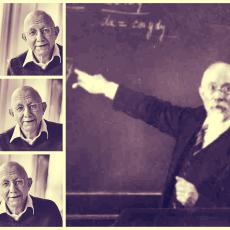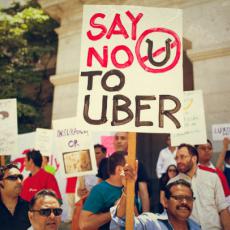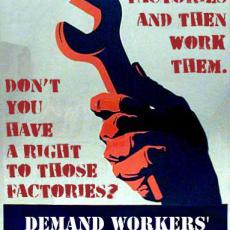Sewer Syndicalism: Worker Self-Management in Public Services
Public services under worker control can serve as demonstration projects to promote workplace democracy and worker empowerment more broadly.
In the late nineteenth and early twentieth centuries, municipal governments in various US cities assumed responsibility for utilities and other services that previously had been privately operated. In the late twentieth century, prompted by fiscal crisis and encouraged by neo-liberal ideology, governments embraced the concept of “privatization, ” shifting management and control over public services to private entities.
Despite disagreements over the merits of privatization, both proponents and opponents accept the premise of a fundamental distinction between the “public” and “private” sectors, and between “state” and “market” institutions. A more skeptical view questions the analytical soundness and practical significance of these dichotomies. In this view, “privatization” is best understood as a rhetorical strategy, part of a broader neo-liberal ideology that relies on putative antinomies of “public” v. “private” and “state” v. “market” to obscure and reinforce social and economic power relations.
While “privatization” may be an ideological definition of the situation, for public service workers the difference between employment in the “public” and “private” sectors can be real in its consequences for job security, compensation, and other respects. Yet, in both the “public” or “private” sectors, workers labor under similar conditions of bureaucratic-managerial control, regardless of whether the boss represents a government agency or private company. Against these sibling forms of hierarchical control, this work posits the alternative of “public service syndicalism,” under which workers themselves take responsibility for managing public service operations.
Worker self-management in public services has been rare in the United States. But examples, both here and elsewhere, do exist. Most recently, the British government, as part of its “Big Society” agenda, has pursued the creation of employee-run public service “mutuals.” Critics within the labor movement and the left have regarded that initiative with suspicion, seeing it as an effort to continue a neo-liberal agenda under the guise of worker empowerment. Yet, the fact that a center-right British government has at least embraced the language of worker control in public services suggests that similar experimentation may be politically feasible in the United States as well.
II. THE PUBLIC-PRIVATE PENDULUM
Over the course of the past hundred or so years, the management of public services has passed back-and-forth between government and private entities. In the late nineteenth and early twentieth centuries, the dominant trend was toward government responsibility for services. In the late twentieth century, a reverse trend of privatization gained momentum. In the early twenty-first century, the picture has been mixed, with both continued privatization in some areas and a return to government operation in others.
A. Municipalization
While municipal government in the United States directly provided some public services in colonial times, the general pattern began with private actors providing services under government regulation, evolving into a system of “direct public subcontracting” in the early nineteenth century, before giving way to direct municipal provision in the late nineteenth and early twentieth centuries. The early twentieth century municipal governments that assumed responsibility for public utilities and services represented the local face of the Socialist and Progressive movements. The differing ideologies of these movements appealed to different core constituencies: Socialists, rooted in the industrial working class and organized labor movement, were devoted to abolishing industrial capitalism in favor of a “Cooperative Commonwealth. ”Progressives, rooted in the professional and managerial middle-class, accepted industrial capitalism and sought merely to ameliorate its more adverse consequences through regulation and reform. Yet, in practice, municipal Socialists and Progressives pursued similar agendas in office, most notably the public ownership of utilities and expansion of services. For Progressives, the primary motivations were concerns over corruption and inefficiency associated with private contractors. Socialists shared these concerns, viewing efficient public services as a means to improve the health and living conditions of working class residents. They also believed that well-functioning Socialist-run cities could provide a working model for a post-capitalist society:
Early twentieth century municipal reforms left a legacy of sanitation systems, water and power utilities, parks and recreation facilities, and other amenities that continued to operate under municipal control long after the Progressive and Socialist administrations that created them were a distant memory. Before the century’s end, however, economic and ideological developments would threaten this legacy.
B. Privatization
During the last decades of the twentieth century, prompted in part by fiscal crisis and encouraged by an ascendant ideology of neoliberalism, a trend emerged toward shifting management and control of public services to the private sector. Privatization has taken various forms, ranging from contracting with private entities to operate and manage certain aspects of services, to selling off services entirely to private organizations. At the municipal level, privatization reached its peak in the late 1990s. By that time, a substantial majority of cities had engaged in at least some form of privatization, affecting about one-fifth of municipal services overall. While nearly all types of service have been subject to some form of privatization, the extent has varied among different types of service. Perhaps symbolizing the high-water mark of the privatization wave, in the late 1990s the City of Milwaukee privatized its municipal sewage system, the very embodiment of “sewer socialism.” More recently, Milwaukee also considered, but ultimately abandoned, a proposal to privatize its water service. The fate of water privatization in Milwaukee is consistent with recent trends, which have seen “reverse contracting” (i. e. governments reassuming direct responsibility for previously outsourced services) matching or outpacing privatizations. There is an extensive body of scholarship on privatization, taking a variety of analytical approaches and offering variously favorable and critical appraisals. Despite the differences, this work generally shares one notable common feature: an inattention to public service workers. While “taxpayers, ” “consumers, ” and “the public at large” are typically identified as relevant “stakeholders” in privatization decisions, the workers engaged in providing services are mostly absent, appearing only indirectly in claims that civil service rules and public-sector unions impair the efficiency of government-provided services. There is little discussion about the effect of privatization on workers, and no consideration of workers’ potential role in service management.
For public service workers, privatization may entail a loss of job protection, reduced wages or benefits, and otherwise less-favorable working conditions as compared to public employment. For the labor movement, which in the United States has become increasingly concentrated in the public sector, privatization threatens a loss of membership and strength. Consequently, public employees and labor unions have generally been strong opponents of privatization.
III. A CRITIQUE OF PRIVATIZATION AS PURE IDEOLOGY
Proponents and opponents of privatization alike share a core assumption: “that there is some distinction between the performance of certain functions by government institutions and performance by private ones, and . . . that the distinction is both real and of very deep significance. ”Yet, for both socio-legal analysts and service workers, the public-private dichotomy may be a distinction with limited difference, bearing neither the normative weight it carries in jurisprudential theory, nor the analytical weight it carries in economic argument. As a practical matter,
the basic choice in the organization of society is not between organization by government bureaucracy on one hand, and markets on the other—a choice that is assumed in the privatization literature. Rather, the basic choice is between two kinds of bureaucracy, which really do not differ much at all.
This is particularly true from the perspective of workers. Under both government and private management, employees carry out tasks assigned by, and under the supervision and control of, managers who are appointed by, and ultimately accountable to, capital asset owners. In their day-to-day experiences on the job, public and private sector employees alike have little if any self-determination.
That is not to say that the public-private distinction lacks any socio-legal significance. To the contrary, it “plays an important legitimating role in society and …conceals prevalent and very significant maldistributions of power.” As Karl Klare explains, “[t]he primary effect of the public/private distinction is to inhibit the perception that the institutions in which we live are the product of human design and can therefore be changed. ”In the realm of work, the legitimate role of the public-private distinction plays out in the beliefs “that industry and commerce can only function on a largely authoritarian basis, ” and that “the basic principles of democracy do not apply in the workplace. ”This ideological function hides behind the typical framing of privatization as a merely neutral technocratic device for achieving economic efficiency and enhanced performance in existing programs and services. Yet, privatization also has the “potential to rearrange policy landscapes and to affect underlying distributions of power among democratic actors and institutions.” In this sense, privatization is not a value-free economic tool, but very much a political strategy, facilitating substantive changes in policy goals and outcomes, without the same checks and balances, oversight, and accountability that apply to government agencies. From this perspective, privatization is best understood as one element of the multifaceted project of neoliberalism, which has held hegemonic sway over political, economic, and legal discourse and practices for more than three decades. In concrete terms, neo-liberalism “is a shorthand term used to denote a particular set of economic and political policy proposals”, notably “free trade, privatization, reduced government spending, and deregulation of capital flows. ”Neoliberalism’s broader significance, however, is ideological: a set of “cultural conceptions that governments and financial agencies attempt to apply and enforce along with and through economic and political practices.” In this broader ideological sense, neoliberalism represents a “sophisticated class struggle on the part of the upper strata [in society] to restore class dominance.” Neo-liberalism asserts that the only legitimate social institution is the market, and that the only legitimate social actor is the individual, particularly the individual as consumer. There is no room, in the neo-liberal worldview, for non-market institutions or collective action. Within that worldview, privatization appears a “commonsense” solution, because any alternative is either conceived to be inherently and irredeemably deficient (as with public services administered by government and staffed by public employees organized and represented through unions) or utterly beyond the conceptual pale (as with public services administered and staffed by self-managing workers themselves). In turn, the practice of privatization bolsters the hegemony of neo-liberal ideology, by further delegitimizing non-market collective-action modes of service provision.
IV. BEYOND “PUBLIC” V. “PRIVATE”: WORKER SELF-MANAGEMENT AS AN ALTERNATIVE TO BUREAUCRATIC-MANAGERIALISM
A venerable radical tradition has long advocated for direct control and management of productive enterprises by workers themselves. This tradition emphatically rejects “the belief that employees lack the capacity collectively to organize and govern complex industrial enterprises.”The argument for worker control is two-fold. Most immediately, self-management is a more democratic alternative to both privately-owned and state-owned modes of bureaucratic-managerial control. More broadly, the exercise of worker control within particular enterprises is a prefigurative practice for attaining the goal of “building a new world within the shell of the old. ”In this dual sense, worker control “operates as a counterlogic to the individualized and materialist conception of citizenship promoted by neoliberal capitalism.”
A. Worker Control in Theory
Dow offers a comprehensive theoretical and empirical assessment of worker control as an alternative mode of firm governance. He distinguishes four ideal-types of firm governance, based on two structural-functional dimensions: ownership of capital assets, and control over production. Along the first dimension, the distinction is between “private” and “public” ownership. Along the second dimension, the distinction is between control by providers of capital (i. e. owners) and control by providers of labor (i. e. workers). In this typology, a capital-managed firm is “capitalist” if assets are privately owned and “socialist” if assets are publicly owned, while a labor-managed firm is “laborist” if assets are privately owned and “self-managed” if assets are publicly owned.
The discourse of privatization typically presumes that, regardless of whether service operations are in public or private hands, control rights will be exercised by management on behalf of asset owners. That is, the choice is presumed to be between control by government managers (in cases where government directly provides services) or control by private managers (in cases where government sells, leases, or contracts for management of service operation).
Dow’s formulation highlights the option of worker self-management as an alternative to both state-managed and privatized services. In this respect, he echoes a long-standing radical-left critique of government ownership as an incomplete and inadequate alternative to capitalist exploitation of labor. Reviewing and critiquing the most common normative justifications for worker control, Dow suggests that the most persuasive are those based on the values of dignity and community. The authoritarian nature of traditional employment relations, whether in the private or public sector, undermines these values. In contrast, worker self-management enhances the dignity of workers by liberating them from subaltern status, and nurtures solidarity among workers by restructuring their work within a social relation of mutual responsibility. In the dominant conception of a “public-private distinction, ” the workplace is located in the “private” sphere, where “public” values like dignity and community are inapplicable. Dow’s argument for extending these values into the workplace implicitly rejects the public-private bifurcation, and instead recognizes that the workplace is not sharply bounded-off from other sites of social existence:
B. Worker Control in Practice
There has been only limited experience with worker-run public services in the United States. Outside the United States, worker control in public services has been put into practice in at least two significant, and very different, cases: in Spain during the civil war of 1936–39, and in Great Britain under the current Conservative/Liberal-Democrat coalition government’s Big Society program.
1. Worker-Run Public Services in the United States
The most fertile ground for experiments in worker-controlled public services in the United States has been in public education. Several teacher-run schools have been established, in some cases with the support of local teachers unions. Such schools currently operate in large cities including New York, Los Angeles, Detroit, Milwaukee, Boston, and Newark, and in smaller districts like Le Sueur-Henderson, Minnesota.
One false start in the direction of worker-run public services emerged in New York City in 2010. The New York City Taxi and Limousine Commission (“TLC”) announced a “Group Ride Vehicle Pilot Program,” under which private commuter-van services would replace bus lines formerly operated by the Metropolitan Transit Authority (MTA) in Brooklyn and Queens. Transit Workers Union Local 100 (“Local 100”), which represents MTA bus drivers, sought an injunction to halt the pilot program. Alongside its legal challenge, Local 100 also submitted a proposal to operate its own commuter-van service under the pilot program. The union’s plan was to operate the service under a non-profit corporation, TWU Express, and to hire laid-off bus drivers at prevailing union wages. The TLC appeared poised to accept the Local 100 bid. However, shortly after the court denied Local 100’s request for an injunction, the union abandoned its plan to operate the commuter-van service.
2. Public Service Syndicalism in Civil War Spain
A dramatic example of worker control in public services occurred during the Spanish Civil War (1936–39). In Barcelona and the surrounding region, workers assumed control over what had been privately-owned commercial and industrial enterprises, including (but by no means limited to) those engaged in public utilities and services. These included water, gas, and electric utilities; telephone services; railways, ports, and municipal transit; health services; and even hairdressing shops. Despite its historical significance, the Spanish experience—emerging under the extreme circumstances of wartime, and brought about spontaneously by a working class with a deep and rich anarchist and syndicalist tradition— might appear to have limited precedential value in the very different conditions of the United States today. A more recent case, in a social and economic context more closely resembling our own, offers better support for the premise that it may be feasible to implement some form of worker self-management in public services here.
3. Public Service Mutuals in Great Britain
In 2010, the British government launched a new program of “mutualization,” under which public service workers would assume managerial responsibility from government authorities. The initiative began with a pilot program under which management of selected service entities was transferred from public authorities to employee-controlled “Pathfinder mutuals.” The pilot entities “cover a wide variety of sectors, including health, social care, youth services, school support services and further education.” The stated motivation for the program was to “challenge traditional public service structures and unleash the pent-up ideas and innovation that has been stifled by bureaucracy.” The hope was that the mutual model would “liberate public sector workers and ‘introduce radical shifts in ownership, accountability and financing. ’ ”Proponents anticipated that the change would lead to enhanced service quality for users, and enhanced working experiences for employees. Despite the vaunted benefits for workers, the mutualization plan came under fire from labor unions representing public service employees. In response to the government’s announcement of the Pathfinder Mutual program, one union leader asserted, “There is no appetite from the public sector workforce or the public generally for these so-called co-operatives. It is insulting to think that these DIY co-operatives, set up on the cheap, can replace a well-established and joined-up public sector. ”In particular, these critics were unpersuaded by the analogy to employee co-operatives in the commercial sector.
To think that cancer treatment can be equated with the values of the retail sector beggers belief. And to keep repeating the words ‘John Lewis’ as the reasoning for these changes is just mangling and perverting the English language. You go to John Lewis to buy a sofa or a fridge, not to have chemotherapy. Dismissing claims that the initiative would promote service enhancements and worker autonomy, another union leader contended that, “[t]he coalition’s resort to mutuals as an alternative to directly provided public services is largely an attempt to save money on reduced pay, conditions, and pensions. ”
For such opponents, the mutualization policy represents little more than an effort to mask Thatcherism with a cooperative face. Behind the rhetoric of social enterprise and worker empowerment they see the same project of dismantling what remains of the welfare state and demolishing what remains of the trade union movement. Indeed, the Big Society program has roots in efforts, dating back to the 1980s, to identify “alternatives to the central state as the supplier of various types of public goods. ”On the political right, a key proponent was British Conservative Party figure James Douglas, who argued for increasing the role of the so-called “Third Sector” as an alternative to state provision, favored by the social-democratic left, and for-profit enterprise, favored by then-dominant strands of the New Right. He specifically identified “mutual associations” among the Third Sector organizations that could replace government as providers of benefits and services. In this sense, the turn from privatization to mutualization does not represent a repudiation of Thatcherism, so much as a continuation of its core project—disabling “source[s] of countervailing power in the state”—by other means. Labor opposition also reflected concerns about the material impact of mutualization on pay, benefits, and job security for service workers. Specifically, while pensions for existing workers will be unaffected by the move from government employment to the mutual setting, new employees will not enjoy such protection. In addition, without policies and practices in place to ensure access to capital, cultivation of management capacities, and other supportive resources, there are concerns about the ability of employee mutuals to survive in competition with larger, better-capitalized market participants.
V. TOWARD A LEGAL FRAMEWORK FOR PUBLIC SERVICE SYNDICALISM
Radical forms of worker control “tend to arise ‘spontaneously,’ without conscious preparation.” Historically, worker control emerges in the wake of a “major crisis” through the autonomous effort of workers already exhibiting “a high level of independent organization.” The case of worker-run public services in Civil War-era Spain exemplifies this pattern.
Yet, the case of public service mutuals in Britain suggests the possibility of promoting some form of worker self-management in public services through deliberate policy and legal intervention. The British case further suggests that experiments in worker-controlled public services may be politically feasible in the United States as well.
A legal framework to promote worker self-management in public services could entail a mix of preferences in favor of worker-run service contractors, along with educational and training programs, and financial support for worker-run entities. This framework draws on existing policy in the area of government contracts, as well as past practices and proposed legislation aimed at supporting worker ownership in the manufacturing sector.
When contracting for goods and services, government at the federal, state, and local levels commonly grants preferences in favor of certain bidders to promote social policy goals. Preferences in favor of small businesses—predicated on beliefs about the significance of small business for maintaining a “competitive free-enterprise system,” promoting entrepreneurship and innovation, and spurring job creation—are well established and enjoy substantial popular support. Preferences in favor of minority or female-owned businesses have been used as a tool for promoting equal economic opportunity. State and municipal governments grant preferences for businesses that are locally-based or employ local residents, to foster the development and stability of local economies. In similar fashion, state and local governments could enact preferences in favor of worker-controlled entities when contracting for public services. Indeed, such preference would also advance the same policy goals underlying existing preferences for small, local, and minority or female-owned businesses. By their nature, public service syndicates would be locally-based small enterprises, employing local residents, because “women and African Americans constitute a disproportionately large share of the state and local public-sector workforce, ”policies favoring public service syndicates would also promote affirmative action goals. At the same time, unlike traditional preferences, public service syndicalism would also promote workplace democracy and worker empowerment.
Another way to support worker self-management in public services is through education and outreach to raise awareness of this model among workers and the general public, and technical assistance for workers starting or running public service syndicates. At least in the early stages, state and local governments can provide these resources, either directly or through grants to non-governmental organizations. As with contracting preferences, this would not represent a radically new policy or government role, but rather a refocusing of existing programs to include support for worker-controlled enterprises. As a network of public service syndicates develops, they will be able to take on this role themselves, sharing information and advice based on their own experiences.
Government can also provide direct loans, loan guarantees, or other forms of financial assistance for public service syndicates. Once again, there is precedent for this government role, for example in government programs that provide start-up loans for small businesses. Indeed, state and local governments have facilitated worker buyouts of private firms through loans and loan guarantees. Finally, tax law represents another vehicle by which government can support worker self-management in public services. Federal and state governments can offer tax incentives for transferring managerial control in existing entities to workers, and accord preferential tax treatment for public service syndicates.
VI. CONCLUSION
In the current US political climate, the prospects of implementing a robust form of public service syndicalism will surely appear remote. Yet, the example of Britain suggests that at least measured steps in that direction might be politically feasible here. Particularly at the state and municipal levels, there may be opportunities to engage in “novel social and economic experiments” with worker-run public services. Through such experimentation, public services under worker control can serve as demonstration projects to promote workplace democracy and worker empowerment more broadly.
This text is reproduced without its sources and footnotes for readability. For the complete article, click on the link below.






Comments
Post new comment